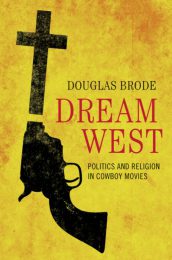The myth and cultural legacy of one of the most powerful American symbols, the cowboy, is at the center of Douglas Brode’s volume Dream West.
While it is not so much the cowboy itself that is analyzed and put in relation to other national icons, it is the set of values and the way the cowboy has altered and continues to change American attitudes in terms of politics, law, economic system and personal conduct.
 One of the reasons for this omnipresence in popular culture are the many Western movies and frontier-theme motion pictures that came up in the early 1920s and still have an impact on the way the American past is conceived.
One of the reasons for this omnipresence in popular culture are the many Western movies and frontier-theme motion pictures that came up in the early 1920s and still have an impact on the way the American past is conceived.
However, the movies also serve as (mystified and largely incorrect) construction of a mostly fictional society, where -after all- it was easy to tell the good ones from the bad ones.
Douglas Brode has shown his rich understanding of American mythology and national film heritage in previous books on Disney movies, counterculture, and aspects of another American spectacle, Star Wars, as an editor. In the book at hand, he again places fictional accounts of one genre (the Western movie) against historical accounts and facts as well as the religious and largely political background of some all-American heroes and substantial incidents.
In detail, those are the frontiersman, the cowboy, the lawman, the O.K. Corral, the American-Mexican war and the Battle of the Alamo, the Civil War as well as important (civil) institutions such as the courtroom, the church, and other locations coming to early fame in the western movie like the saloon or the distant farm. He finds evidence for his theories and conclusions in the roughly 300 western movies he quotes and refers to: often in great detail.
However, those old days when even the bad guys and hired gunmen followed some kind of moral codex, a town or a community stuck together, A place where democracy and the law were respected never actually existed. Hence a string of bitter movies with a bleak outlook on American communities surfaced in the 1950’s, mirroring the McCarthy years.
Each decade from the 1920’s onwards had its individual image of the West, and some directors changed their approach to the Western over the years. “More often than not, that tradition of the Old West was created by blue-state literary lights and cinematic geniuses who glorified or degraded the frontier experience in view of their own attitudes.” For example, “King of the Cowboy Roy Rogers may have popularized the tune ‘Don’t Fence Me In,’ but that beloved ode to freedom was written by legendary Manhattan sophisticate Cole Porter.”
As a result Brode here presents a good overview of the image of the West according to Clint Eastwood, John Ford, Sam Peckinpah and other directors, each one “recreating” their very own myth. Brode highlights a number of distinctive contrasts, and again the reader realizes that there are various ways to represent even simple “natural” parts of the cowboy environment, such as the open range, the prairie (without fences) and abstract concepts such as freedom, equality, democracy, different political ideas and a set of conceptions involving the idea of “justice.”
With this briefing we learn about another mythical term, namely “The Code of the West.” It is most likely a charming idea; Brode identifies it as a concept of “… America itself, distilled from actual history into a dream of who Americans should and ideally could be as people. That code, a twentieth-century conception in popular arts, narrative and visual, derived from Romantic notions of European chivalry. Imposed on nineteenth-century fictional and nonfictional characters and settings, the code was ingested into a mythology that for much of the same citizenry no longer holds true during the twenty-first century.”
For fans of classic movies such as High Noon, Hondo, My Darling Clementine, The Alamo, Gunfight at O.K. Corral, Red River and scholars of American popular culture alike this title will be a very illuminating and entertaining read.
Review by Dr. A. Ebert © 2015
Douglas Brode. Dream West. Politics and Religion in Cowboy Movies. University of Texas Press, 2013, 390 p.
